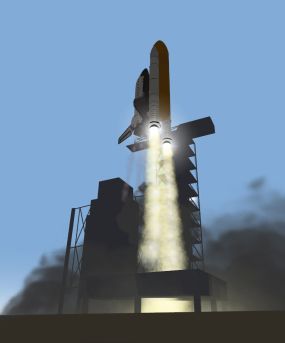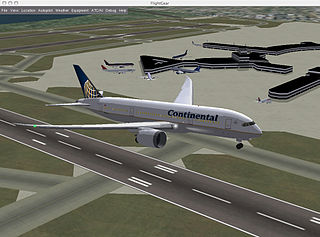
A flight simulator is a device that artificially re-creates aircraft flight and the environment in which it flies, for pilot training, design, or other purposes. It includes replicating the equations that govern how aircraft fly, how they react to applications of flight controls, the effects of other aircraft systems, and how the aircraft reacts to external factors such as air density, turbulence, wind shear, cloud, precipitation, etc. Flight simulation is used for a variety of reasons, including flight training, the design and development of the aircraft itself, and research into aircraft characteristics and control handling qualities.

A model aircraft is a physical model of an existing or imagined aircraft, and is built typically for display, research, or amusement. Model aircraft are divided into two basic groups: flying and non-flying. Non-flying models are also termed static, display, or shelf models.

Microsoft Flight Simulator is a series of flight simulator programs for MS-DOS, Classic Mac OS, and Microsoft Windows operating systems. It was an early product in the Microsoft application portfolio and differed significantly from Microsoft's other software, which was largely business-oriented. As of November 2022, Microsoft Flight Simulator is the longest-running software product line for Microsoft, predating Windows by three years. Microsoft Flight Simulator is one of the longest-running PC video game series of all time.

Orbiter is a space flight simulator program developed to simulate spaceflight using realistic Newtonian physics. The simulator was released on 27 November 2000; the latest edition, labeled "Orbiter 2016", was released on 30 August 2016, the first new version of the simulator since 2010. On 27 July 2021, Dr Schweiger announced to the Orbiter Community that Orbiter is being published under open source MIT license.

Virtual Air Traffic Simulation Network (VATSIM) is a nonprofit organization that operates an online flight-simulation network noted for its active membership and realism. Users are able to connect to VATSIM and fly aircraft as a pilot, or direct traffic as an air traffic controller in what has been described as a close approximation of real-life aviation procedures.

A radio-controlled aircraft is a small flying machine that is radio controlled by an operator on the ground using a hand-held radio transmitter. The transmitter continuously communicates with a receiver within the craft that sends signals to servomechanisms (servos) which move the control surfaces based on the position of joysticks on the transmitter. The control surfaces, in turn, directly affect the orientation of the plane.
Combat flight simulators are vehicle simulation games, amateur flight simulation computer programs used to simulate military aircraft and their operations. These are distinct from dedicated flight simulators used for professional pilot and military flight training which consist of realistic physical recreations of the actual aircraft cockpit, often with a full-motion platform.

A radio-controlled helicopter is model aircraft which is distinct from a RC airplane because of the differences in construction, aerodynamics, and flight training. Several basic designs of RC helicopters exist, of which some are more maneuverable than others. The more maneuverable designs are often harder to fly, but benefit from greater aerobatic capabilities.
Precision Manuals Development Group is a commercial add-on aircraft developer for the Microsoft Flight Simulator, Lockheed Martin Prepar3D, and X-Plane series. The company was founded by Robert S. Randazzo, who stated that his ultimate goal was to develop the software to the point where it could be used by airlines and manufacturers to supplement pilot training. The company is based out of Las Vegas, Nevada but has several employees in countries such as Belgium, South Africa, and Canada. It has eight employees as of 2018, with a collection of beta testers which include multiple aviation professionals.

An RC flight simulator is a computer program that allows pilots of radio-controlled aircraft to practice on a computer, without the risk and expense of damaging a real model. Besides the obvious use of training beginners, they are also used for practising new aerobatics, evaluating a model before buying it, and to allow flight practice when conditions are otherwise unsuitable. Most simulators allow the use of real R/C transmitters to control the sim.
Microsoft Flight Simulator began as a set of articles on computer graphics, written by Bruce Artwick throughout 1976, about flight simulation using 3-D graphics. When the editor of the magazine told Artwick that subscribers were interested in purchasing such a program, Artwick founded Sublogic Corporation to commercialize his ideas. At first the new company sold flight simulators through mail order, but that changed in January 1979 with the release of Flight Simulator (FS) for the Apple II. They soon followed this up with versions for other systems and from there it evolved into a long-running series of computer flight simulators.

Microsoft Flight Simulator X is a 2006 flight simulation video game originally developed by Aces Game Studio and published by Microsoft Game Studios for Microsoft Windows. It is the sequel to Microsoft Flight Simulator 2004 and the tenth installment of the Microsoft Flight Simulator series, which was first released in 1982. It is built on an upgraded graphics rendering engine, showcasing DirectX 10 features in Windows Vista and was marketed by Microsoft as the most important technological milestone in the series at the time. FSX is the first version in the series to be released on DVD media.
Hardware-in-the-loop (HIL) simulation, also known by various acronyms such as HiL, HITL, and HWIL, is a technique that is used in the development and testing of complex real-time embedded systems. HIL simulation provides an effective testing platform by adding the complexity of the process-actuator system, known as a plant, to the test platform. The complexity of the plant under control is included in testing and development by adding a mathematical representation of all related dynamic systems. These mathematical representations are referred to as the "plant simulation". The embedded system to be tested interacts with this plant simulation.
Horizon Hobby, LLC is an American multinational hobby-grade RC radio control (RC) model, model train manufacturer, and distributor. It was founded by Rick Stephens, Janet Ottmers, Debra Love, and Eric Meyers, in July 1985, and headquartered in Champaign, Illinois. Horizon Hobby products are sold in more than 50 countries. Additional facilities are in California and abroad in the United Kingdom, Germany, and China.

Third Wire Productions Inc. is a C corporation based in Austin, Texas, United States; it is an independent software development company founded in 1999 to create multimedia entertainment, such as amateur flight simulators and strategy video games.

A flight simulation video game refers to the simulation of various aspects of flight or the flight environment for purposes other than flight training or aircraft development. A significant community of simulation enthusiasts is supported by several commercial software packages, as well as commercial and homebuilt hardware. Open-source software that is used by the aerospace industry like FlightGear, whose flight dynamics engine (JSBSim) is used in a 2015 NASA benchmark to judge new simulation code to space industry standards, is also available for private use. A popular type of flight simulators video games are combat flight simulators, which simulate combat air operations from the pilot and crew's point of view. Combat flight simulation titles are more numerous than civilian flight simulators due to variety of subject matter available and market demand.
3D Aerobatics or 3D flying is a form of flying using flying aircraft to perform specific aerial maneuvers. They are usually performed when the aircraft had been intentionally placed in a stalled position for purposes of entertainment or display. They are also often referred to as post-stall maneuvers, as they occur after aerodynamic stall has occurred and standard control surface deflections, as used in flight, are not effective.

IL-2 Sturmovik is a series of World War II combat flight simulation video games originally created in 2001 by Russian video game developer Maddox Games under the brand name 1C:Maddox Games, following its association with 1C Company. Maddox Games left 1C Company in 2011. Since 2012, 1C's new developers are 1C Game Studios and Team Fusion Simulations. Thus, 1C Company currently owns the IL-2 Sturmovik label and runs three different accumulated generations of IL-2 games.
ArduPilot is an open source, uncrewed vehicle Autopilot Software Suite, capable of controlling:

Microsoft Flight Simulator is a flight simulation video game developed by Asobo Studio and published by Xbox Game Studios. It is an entry in the Microsoft Flight Simulator series which began in 1982, and was preceded by Microsoft Flight Simulator X in 2006. The game is a return of the series after 14 years, with development beginning six years prior to its release. It was released on August 18, 2020, for Windows, with a virtual reality (VR) version released in December of the same year as part of the free Sim 2 update. Microsoft Flight Simulator is the first game in the series to see a VR and console release, with it being released on the Xbox Series X and Series S on July 27, 2021.













